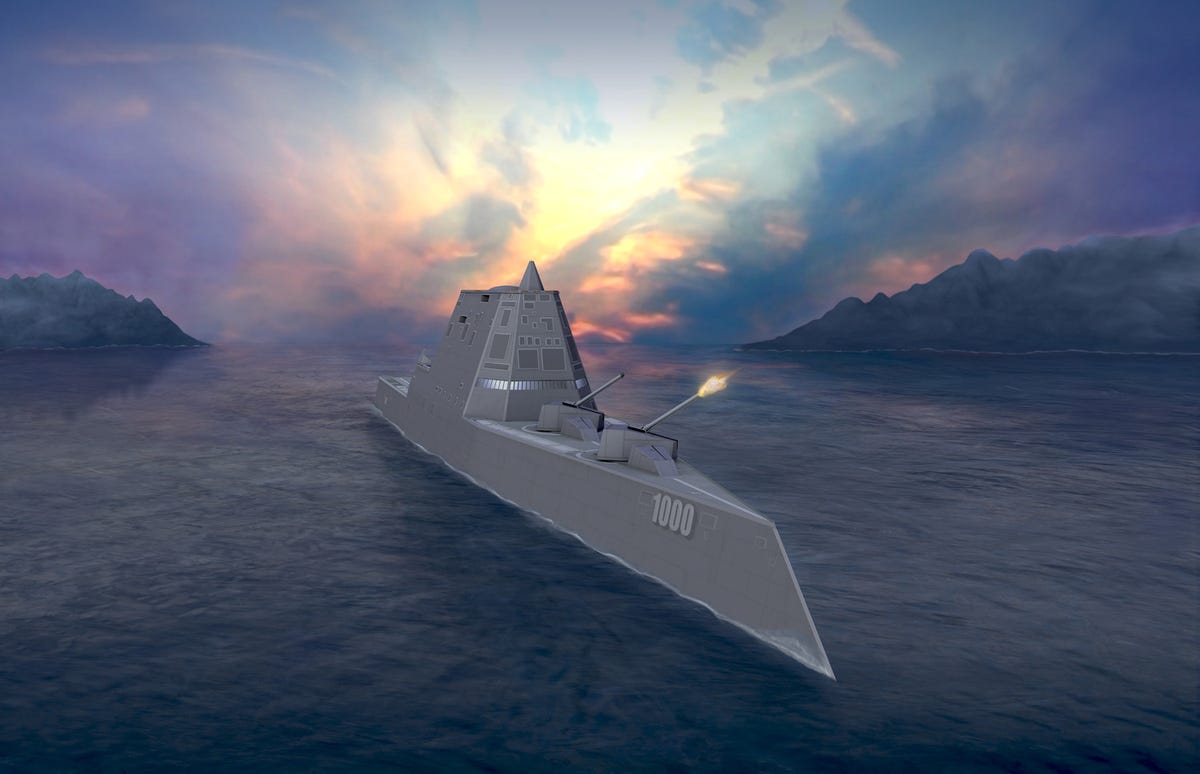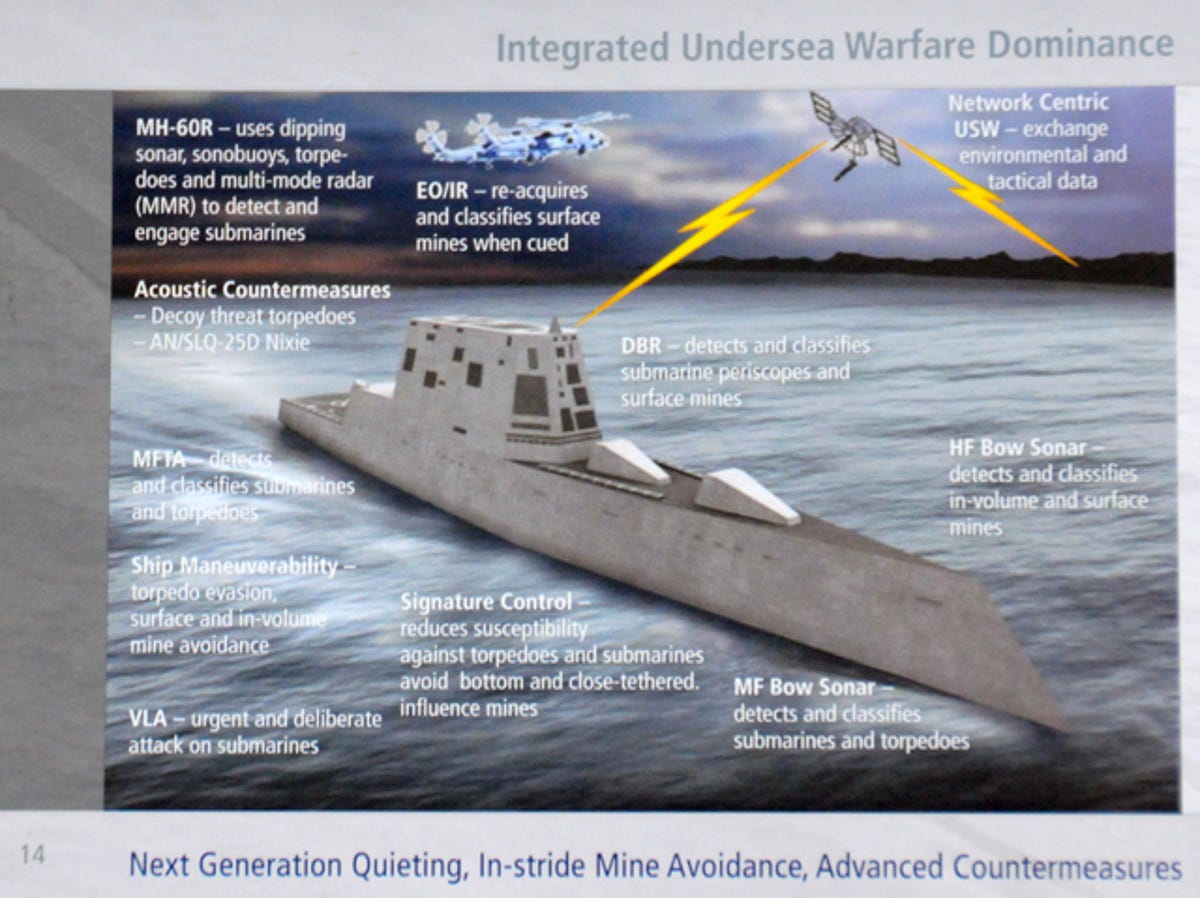The Navy's next-generation destroyer (photos)
Road Trip 2010: CNET reporter Daniel Terdiman gets a behind-the-scenes look at the innovations of the Zumwalt-class destroyer.

The DDG 1000
PORTSMOUTH, R.I.--When someone says that a new Naval vessel will be "the centerpiece of seapower for the next 50 years," it's tempting to be skeptical. But with the U.S. Navy's next-generation Zumwalt-class destroyer, known as DDG 1000, it's worth keeping an open mind.
With the Zumwalt, the Navy is aiming for a much larger, much more efficient, much quieter and hard-to-detect destroyer geared toward the water-borne battlefields of the future.
As part of Road Trip 2010, CNET reporter Daniel Terdiman visited defense giant Raytheon's Integrated Defense Systems facility here for a lengthy discussion of the DDG 1000 and the ways it is expected to break new ground in naval warfare.
Seen here is a rendering of the Zumwalt class destroyer, the design of which is being led by Raytheon, but which also features work by partners at BAE Systems, General Dynamics, Lockheed Martin, Northop Grumman, and of course, the Navy.
The ship is being built at the Bath Iron Works, in Bath, Maine.
Click here to read the related story on the U.S. Navy's next-generation destroyer, the DDG 1000, and click here to check out the entire Road Trip 2010 package.
The third Zumwalt
The Zumwalt class will feature three ships: the USS Zumwalt--DDG 1000, the USS Michael Monsoor--DDG 1001, and the as yet named DDG 1002, seen here in an artist's rendering.
Click here to read the related story on the U.S. Navy's next-generation destroyer, the DDG 1000, and click here to check out the entire Road Trip 2010 package.
Dual band radar test site
One of the most innovative features of the Zumwalt class destroyers is its dual-band radar. This is a scale model of the radar, based at the Navy's Engineering Test Center, part of the Wallops Flight Facility, which is run by NASA, on Wallops Island, Va. Naval personnel are currently being trained on the dual-band radar at this facility.
Click here to read the related story on the U.S. Navy's next-generation destroyer, the DDG 1000, and click here to check out the entire Road Trip 2010 package.
Wallops engineering test center
Another view of the Navy's scale model of the dual-band radar for the DDG 1000, based at the Navy's Engineering Test Center, adjacent to NASA's Wallops Flight Facility on Wallops Island, Va. It is seen here in a Road Trip 2010 photograph by CNET reporter Daniel Terdiman.
Click here to read the related story on the U.S. Navy's next-generation destroyer, the DDG 1000, and click here to check out the entire Road Trip 2010 package.
Mission center
Seen here at Raytheon's Seapower Capability Center in Portsmouth, R.I., is a replica of the DDG 1000's actual bridge.
Click here to read the related story on the U.S. Navy's next-generation destroyer, the DDG 1000, and click here to check out the entire Road Trip 2010 package.
Total ship computing environment
The DDG 1000 Total Ship Computing Environment is a new systems architecture that is open and advanced and that offers a scalable platform for a new set of cost-efficient mission capabilities while also leveraging existing lines of code from Navy programs.
Click here to read the related story on the U.S. Navy's next-generation destroyer, the DDG 1000, and click here to check out the entire Road Trip 2010 package.
Electronic Modular Enclosures
The Electronic Modular Enclosures, seen here at Raytheon's Seapower Capability Center in Portsmouth, R.I., offer technology that is aimed at putting the Navy far ahead of its adversaries, while saving money through the latest techniques.
Click here to read the related story on the U.S. Navy's next-generation destroyer, the DDG 1000, and click here to check out the entire Road Trip 2010 package.
Replica
A replica of the DDG 1000, seen at Raytheon's Seapower Capability Center, in Portsmouth, R.I.
Click here to read the related story on the U.S. Navy's next-generation destroyer, the DDG 1000, and click here to check out the entire Road Trip 2010 package.
Comparison
A data sheet showcases the comparison between the next-generation DDG 1000 and the current-gen DDG 51. The Zumwalt class destroyer is 610 feet long and has a flight deck 150 feet by 51 feet, while the DDG 51 is just 509 feet long with a flight deck just 71 feet by 57 feet.
Click here to read the related story on the U.S. Navy's next-generation destroyer, the DDG 1000, and click here to check out the entire Road Trip 2010 package.
Deep strike
The DDG 1000 is designed to both aim high-precision fire in the areas near shore that could harbor enemies, while also being able to aim several different rounds of artillery at a group of targets with the idea of scaring them into compliance.
Click here to read the related story on the U.S. Navy's next-generation destroyer, the DDG 1000, and click here to check out the entire Road Trip 2010 package.
Advantage
Because of advances in the acoustics of the DDG 1000, it is designed to have a much wider range in which it can travel quietly--and therefore safely. In these two images, the colors designate the differences between the current-generation DDG 51's capabilities, and those of the DDG 1000.
Click here to read the related story on the U.S. Navy's next-generation destroyer, the DDG 1000, and click here to check out the entire Road Trip 2010 package.

Undersea warfare dominance
This image showcases the DDG 1000's underwater capabilities, including technologies for "in-stride mine avoidance," "advanced countermeasures," and "next-generation quieting."
Click here to read the related story on the U.S. Navy's next-generation destroyer, the DDG 1000, and click here to check out the entire Road Trip 2010 package.
Advanced acoustic sensor suite
The Zumwalt will feature the state of the art in acoustic sensors.
Click here to read the related story on the U.S. Navy's next-generation destroyer, the DDG 1000, and click here to check out the entire Road Trip 2010 package.
Configuration
A side-view schematic of the DDG 1000.
Click here to read the related story on the U.S. Navy's next-generation destroyer, the DDG 1000, and click here to check out the entire Road Trip 2010 package.

